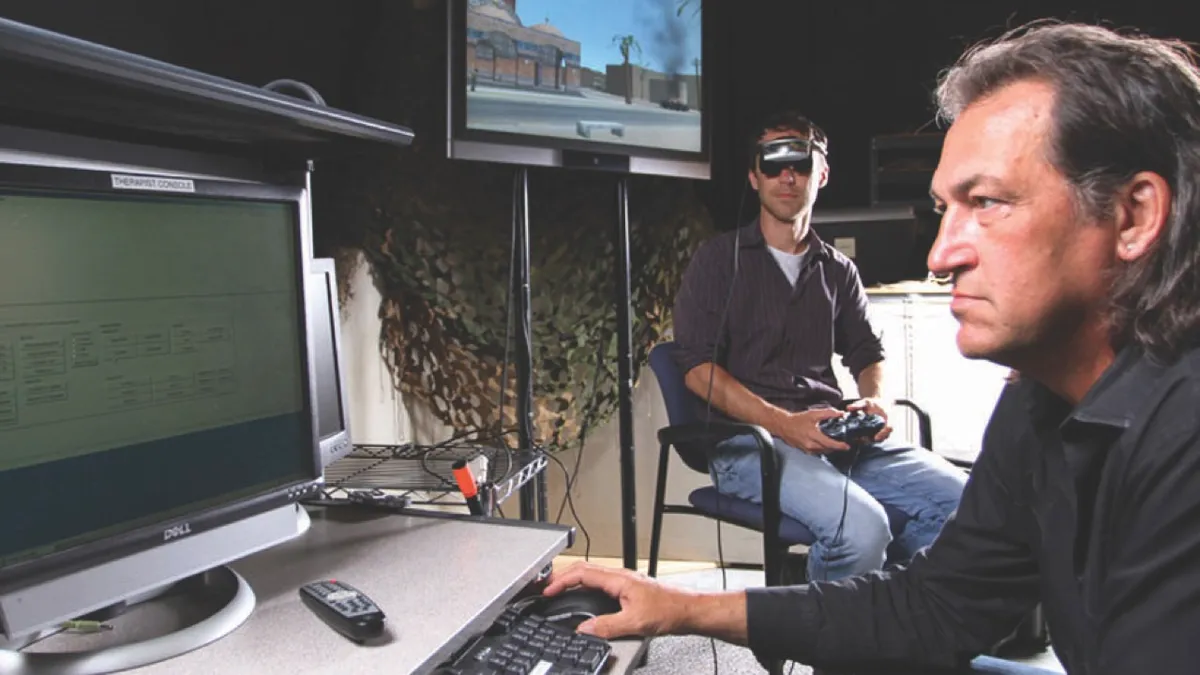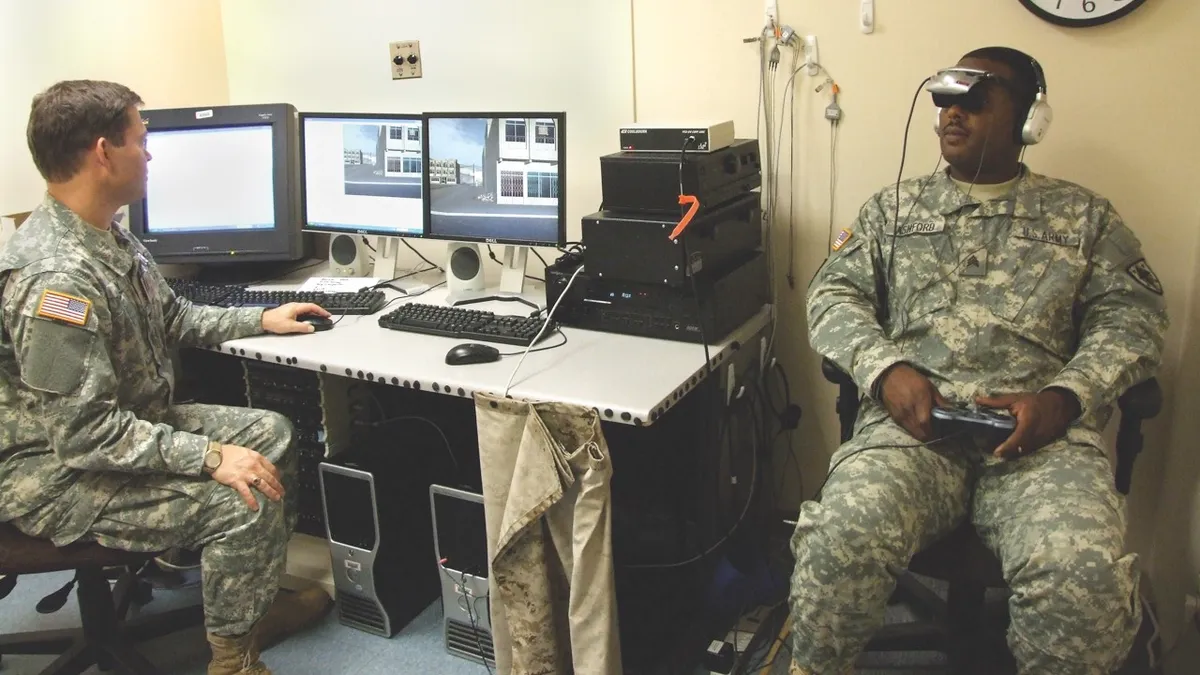VR’s growth in popularity stems from transporting individuals to simulated environments that present no real, physical danger to the person immersed in them. Being simulated also means those environments can be precisely calibrated to deliver a tailored scenario appropriate to that person. These two characteristics make VR a valuable tool for conducting ‘exposure therapy’, in which patients with anxiety-related conditions, such as post-traumatic stress disorder (PTSD), repeatedly confront the cues that trigger their stress reactions.
Prototype VR exposure therapy applications began appearing in the 1990s but were held back by capabilities of the technology available at the time. But as the technology improved, so too has VR therapy’s potential. Now it’s reached a point where all branches of the US military are funding a VR PTSD treatment developed specifically for servicemen and women returning from the wars in Iraq and Afghanistan.
Read more:
- Changing our behaviour with virtual reality - Jeremy Bailenson
- How virtual reality helps spot suicidal tendencies
“Traditional exposure therapy to treat PTSD relies on imagination alone; the person has to imagine the situation related to the trauma,” explains Albert ‘Skip’ Rizzo, director of medical virtual reality at the University of Southern California’s Institute for Creative Technologies.
“But one of the cardinal symptoms of PTSD is avoidance – avoidance of the cues and reminders of the trauma. So it’s a tall order to expect someone to create a vivid mental image of something that they’ve been spending their whole time trying to avoid.
“We take that same exposure therapy protocol but deliver it using VR simulations so that we’re not relying exclusively on the person’s imagination,” Rizzo continues. “We place the person in VR simulations that the clinician can control in real time and customise based on that person’s experience.”

Recreating trauma
The therapy starts with a discussion between the patient and the clinician to determine if the VR therapy – christened ‘Bravemind’ – is appropriate. If so, a traumatic memory is selected and used as the basis for a virtual scenario. The patient can then be immersed in that scenario for up to 40 minutes at a time during the 10 weekly sessions.
“The clinician has what we nickname a ‘Wizard of OZ’ control panel, and they start by selecting one of the 14 VR worlds that we’ve created,” says Rizzo. “These worlds vary from a highly populated Middle Eastern city, to marketplaces, mosque areas and slums, to Afghanistan villages and remote mountain outposts. The clinician can put the patient in that world and systematically adjustwhat goes on in it.”
Olfactory stimulation is incorporated by a compressor that blows air over phials containing scents like body odour and diesel.
Once the background to the experience has been decided upon, it’s then a case of questioning the patient to tailor the scenario to their recollection. For instance, were they driving a vehicle, on a foot patrol or manning a gun turret? Did it take place at dawn or later in the day? What sort of noises were heard…?
“All this begins to set up the experience in a way that’s relevant to the patient’s trauma experience,” Rizzo explains. “As they work through this narrative retelling and begin to confront and process these difficult emotional memories, the clinician can make things happen to heighten the realism. He can set off an IED (improvised explosive device) nearby, have a helicopter or a jet fly over, or insurgents appear on a rooftop and fire an RPG (rocket-propelled grenade)… It’s never going to be an exact replica of the trauma experience but it’s close enough to engage the patient in their trauma memories and stir up imagination, all in the context of the safety of the therapeutic environment.”
A scent of resolution
Further ‘realism’ can be added by engaging the patient’s sense of smell. Olfactory stimulation is incorporated by a compressor that blows air over phials containing pellets impregnated with scents such as body odour, gunpowder, burning rubber or diesel.
“I’ll say right upfront that we don’t have the data to say whether odours add to the clinical effect,” says Rizzo. “But we do know that smell is intimately tied in the brain with memory and emotion. So we feel it’s theoretically informed and an important thing to add.”

All of which makes Bravemind sound like an amped-up computer game. But to view it as such is to misinterpret the intention behind it, says Rizzo. “The goal in a game is to find the biggest weapon you can get your hands on and lay waste to everything. If we thought fostering a cathartic revenge fantasy was a healing method for PTSD then we could just use games. But it doesn’t. The difference between a game and Bravemind is that we’re trying to help the patient to confront and process difficult emotional memories.
“Bravemind is about reliving traumatic experiences in a safe environment, so that the experience becomes paired with the safety and support of the clinical environment,” Rizzo continues.
“Gradually, the patient no longer experiences the same level of conditioned fear or anxiety that had previously occurred from the recall of their trauma memories.”
Statistically proven
Trials of an earlier version of the virtual therapy that Bravemind was developed from proved promising with 80% of the patients that completed the treatment showing statistically and clinically meaningful reductions in PTSD, anxiety and depression symptoms.The patients themselves also claimed to have noticed lasting improvements in their everyday life.
So are VR treatments, such as Bravemind, a better alternative to traditional exposure therapy? “Some scientists say adding other elements to the traditional exposure therapy doesn’t really matter – you’re not going to get any better clinical outcomes. I’m not in that camp,” says Rizzo. “I think that the complexity of PTSD calls for other elements that go along with the traditional therapy to help support the patient. It’s not therapy delivered by machine. It’s not designed to replace a clinician. In the end it’s simply a tool to extend the skills of a good clinician to better deliver an already evidence-based therapy for PTSD. Ultimately, that is virtual therapy in a nutshell.”
- This article was first published in May 2016.
Follow Science Focus onTwitter,Facebook, Instagramand Flipboard